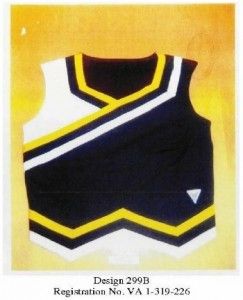Star Athletica, L.L.C. v. Varsity Brands, Inc., 137 S.Ct. 1002 (2017)
On March 22, 2017, the Supreme Court of the United States issued a decision in a highly-anticipated case concerning the copyrightability of clothing designs, concluding that designs on cheerleading uniforms could be protected by U.S. copyright. The Supreme Court rarely takes on copyright cases, and this case has been of particular interest to the fashion industry, which has long bemoaned the scant protection available under U.S. law for clothing designs.
Basic Legal Framework. Since clothing designs serve a function—to cover the body—they are classified under the U.S. Copyright Act as "useful articles," which are excluded from U.S. copyright protection. As useful articles, clothing designs could achieve U.S. copyright protection only if—and only to the extent that—the design "incorporates pictorial, graphic, or sculptural features that can be identified separately from, and are capable of existing independently of, the utilitarian aspects of the article." 17 U.S.C. § 101 ("Section 101").
Figuring out where the utilitarian aspects of clothing end and the copyrightable aspects of clothing begin has befuddled litigants and courts for decades and, by some counts, more than a dozen different and competing legal tests have been developed for determining whether the "separability" requirement of Section 101 is satisfied. Almost all relied on the legislative history of Section 101, which introduced the idea of "physical" and "conceptual" separability. With physical separability, the design features can be physically separated from the useful article while leaving the article intact; with conceptual separability, the design feature cannot be physically separated from the article but is nonetheless recognizable as distinct from the useful article (e.g., an intricate carving of leaves and vines on a chair back).
History of the Case. The case that made its way to the Supreme Court involved two companies that market and sell cheerleading uniforms: Star Athletica and Varsity Brands ("Varsity"). In 2010, Varsity sued Star Athletica alleging infringement of Varsity's copyrights in five cheerleader uniforms bearing designs created from shapes and stripes of colored fabrics. Varsity had obtained U.S. copyright registrations for its cheerleader uniforms as "2-dimensional artwork" or "fabric design (artwork)," and had submitted as specimens sketches or photographs of the uniforms. The following is one of the works at issue:

At the trial court level, upon a motion for summary judgment filed by defendant Star Athletica, the U.S. District Court for the Western District of Tennessee held that Varsity's designs were useful articles and thus not eligible for copyright protection. Varsity Brands, Inc. v. Star Athletica, LLC, No. 10-2508, 2014 WL 819422 (W.D. Tenn. March 1, 2014). More specifically, the District Court concluded that the designs applied to the cheerleading uniforms were part-and-parcel of the function of the uniform itself and, in the words of Section 101, could not "be identified separately from" or "exist[] independently of, the utilitarian aspects of the article." 2014 WL 819422 at *8. As the District Court reasoned, "a cheerleading uniform loses its utilitarian function as a cheerleading uniform when it lacks all design and is merely a blank canvas." Id. The District Court therefore granted summary judgment to defendant Star Athletica.
On appeal, the United States Court of Appeals for the Sixth Circuit disagreed with the District Court's conclusion that the graphic designs were necessary to a cheerleading uniform's purpose. Varsity Brands, Inc. v. Star Athletica, LLC, 799 F.3d 468 (6th Cir. 2015). The Sixth Circuit concluded that the only utilitarian aspects of a cheerleading uniform were to cover the body, permit free movement and wick moisture. Id. at 490. Since the design appearing on the face of the uniforms contributed nothing to these utilitarian aspects, the designs were separable from the utilitarian aspects and therefore eligible for copyright protection. Id. at 491-92. (The Sixth Circuit Court expressly refrained from offering any opinion as to whether Varsity's designs were sufficiently original for copyright protection. Id. at 493.) Our 2015 report of the Sixth Circuit's opinion can be viewed here.
The Supreme Court Opinion. In delivering the opinion of the Court (to which Justices Alito, Kagan, Roberts, and Sotomayor joined), Justice Thomas noted that the Supreme Court had accepted the case to resolve "widespread disagreement" on the proper test to assess separability under Section 101. 137 S.Ct. at 1007. Hewing closely to the language of Section 101, the Court proceeded to set forth a new two-part test, which now applies nationwide:
[A] feature incorporated into the design of a useful article is eligible for copyright protection . . . if the feature (1) can be perceived as a two- or three-dimensional work of art separate from the useful article and (2) would qualify as a protectable pictorial, graphic or sculptural work—either on its own or fixed in some other tangible medium of expression—if it were imagined separately from the useful article into which it is incorporated.
Id. In the Court's view, "[t]he ultimate separability question . . . is whether the feature for which copyright protection is claimed would have been eligible for copyright protection as a pictorial, graphic, or sculptural work had it originally been fixed in some tangible medium other than a useful article before being applied to a useful article." Id. at 1011. Thus, "a feature of the design of a useful article is eligible for copyright if, when identified and imagined apart from the useful article, it would qualify as a pictorial, graphic, or sculptural work either on its own or when fixed in some other tangible medium." Id. at 1012.
In adopting this test, the Court abandoned the distinction between "physical" and "conceptual" separability. Noting that Section 101 does not require the underlying useful article to remain once the design element is separated, the Court concluded that the question is statutorily confined to conceptual separability. Id. at 1014. Relatedly, the Court pointedly rejected the question that had divided the trial and appellate courts—namely, whether a cheerleading uniform can still be a cheerleading uniform without the design elements. The Supreme Court viewed that debate as "unnecessary" since Section 101 requires the focus to be "on the extracted feature and not on any aspects of the useful article that remain after the imaginary extraction." Id. at 1013.
Applying the Court's new test to the cheerleading uniform designs in question, the Court's majority had no trouble finding that the designs satisfied the two-part test and thus are eligible for copyright protection:
First, one can identify the decorations as features having pictorial, graphic, or sculptural qualities. Second, if the arrangement of colors, shapes, stripes, and chevrons on the surface of the cheerleading uniforms were separated from the uniform and applied in another medium—for example, on a painter's canvas—they would qualify as 'two-dimensional . . . works of art,' § 101. And imaginatively removing the surface decorations from the uniforms and applying them in another medium would not replicate the uniform itself. Indeed, respondents have applied the designs in this case to other media of expression—different types of clothing—without replicating the uniform. . . . The decorations are therefore separable from the uniforms and eligible for copyright protection.
Id. at 1012.
The Court was, however, quick to point out that copyright protection (if any) extended only to the designs on the cheerleading uniforms and not the uniforms themselves: "To be clear, the only feature of the cheerleading uniform eligible for a copyright in this case is the two-dimensional work of art. [Varsity] ha[s] no right to prohibit any person from manufacturing a cheerleading uniform of identical shape, cut and dimensions to the ones on which the decorations in this case appear." Id. at 1013. Further, the Court, like the Sixth Circuit before it, expressly refrained from deciding whether the designs, though separable from the useful article and thus eligible for copyright protection, are sufficiently original to qualify for copyright protection. Id. at 1012, n.1.
Thus, we await the trial court's decision on whether Varsity's cheerleader uniform designs qualify for copyright protection now that the Supreme Court has determined that they are copyright eligible. And we will also wait to see the extent to which the Supreme Court's decision and the new nationwide test for separability affect copyright protection for clothing and other fashion designs going forward.
The content of this article is intended to provide a general guide to the subject matter. Specialist advice should be sought about your specific circumstances.


